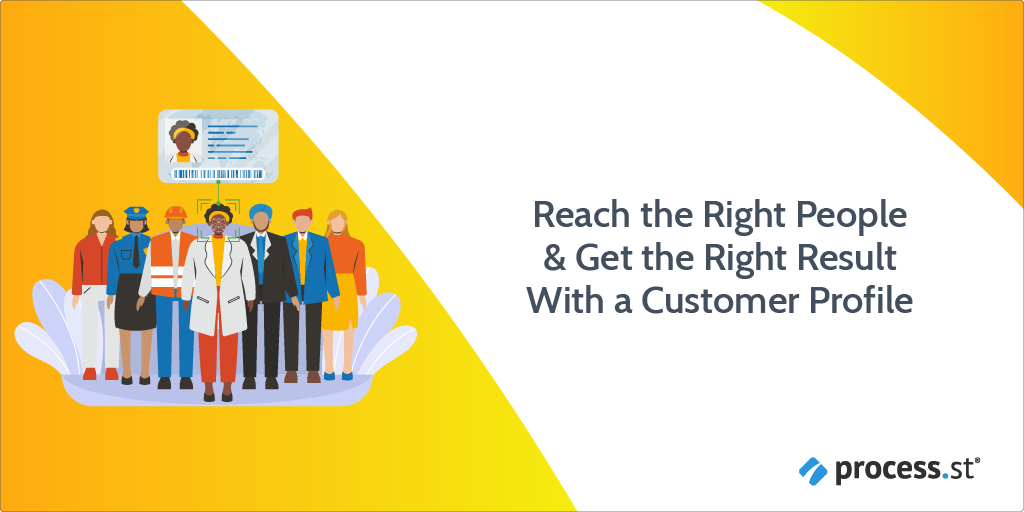
We’ve never met, but I know who you are.
You spend 90% of your day either in meetings or answering emails, so you’re incredibly short on time.
You’re a big believer in “moving fast and breaking things” but over-regulation, cyber threats, obsoletion, and the availability of key skills keeps you awake at night.
You check in with Twitter and Reddit daily to stay in-the-loop, and you’re a keen consumer of content that’s quick and easy to digest, from reputable sources, and provides clear answers to your questions. You hate waffle!
Am I close?!
Whether I’m right or wrong (and before this gets any creepier), I know all this because I’ve created your customer profile, or buyer persona if you prefer.
Organizations that use customer profiles to create and deliver content enjoy 73% higher conversions than those that don’t. So, I used market research and data to build up a semi-fictional representation of you.
I identified your common behavior patterns, discovered what your key motivations were, and established your biggest pain points so I could write a tailored post that clearly answers your questions, provides value, and delivers useful insights.
I won’t lie; this took a lot of time!
But was it worth it?
Take 10 minutes to read this Process Street post and get insights from the likes of Hiten Shah, Lincoln Murphy, and Tomasz Tunguz, learn how to create a customer profile in five simple steps, and find out:
- Can a customer profile really leverage growth?
- What’s the one thing you must do before you create a customer profile?
- What’s the quickest way to create a customer profile that helps you scale?
Let’s “cut fast, cut deep”, and cut the crap.
Can a customer profile really leverage growth?
Yes.
Buyer personas, customer profiles, marketing personas… We all know what these terms mean. They’re all about understanding exactly who your customers are.
But why bother? How will a deep understanding of who your customers are help you scale your business? Surely a customer is a customer, and any sale is a good sale?!
Not if you want to grow your business.
The 2 key drivers of growth

You know that acquiring customers at a low cost and keeping them for as long as possible is the best-kept secret to growth.
Low Customer Acquisition Cost (CAC) + High Lifetime Value (LTV) = Growth
Kinda goes without saying, but if you can acquire new customers at a lower cost, you will make a larger profit. And, if you can keep those customers for a longer time, not only will they become more profitable, but you’ll spend six to seven times less having to acquire new ones to plug the gap when they leave.
“A high LTV/CAC ratio shows that you have figured out efficient methods of attracting and retaining customers. As such, it indicates that your company can grow fast…investors are more interested in companies with a high LTV to CAC ratio, as these companies tend to have higher valuations and more potential for fast growth” – Lighter Capital, What Does Your LTV/CAC Ratio Tell You?
But how does a customer profile lower your CAC, increase your LTV, and therefore help you grow?
How can a customer profile lower my CAC?
Ineffective marketing tactics to acquire customers are one of the biggest ways to increase your CAC. Burning money on big marketing initiatives that fall on deaf ears, or on expensive and time-consuming activities such as cold calling, prospecting, and running high-touch sales processes can raise your CAC dramatically.
If you have a customer profile you’ll know exactly who you’re targeting. You’ll know how they’re likely to behave, which channels they’re receptive to (and which they’re not), and what type of messaging they find engaging. It allows you to efficiently and effectively create and deliver focused messages that reach your customers at the right time and in the right way, therefore lowering your CAC.
For example, JetBlue airlines use customer profiles to support their marketing strategies. Their primary customer profile is the low-budget traveler that’s looking for a comfortable yet affordable airline.

After researching this customer profile, they learned that this type of audience was young and made the majority of their decisions through social media.
So, they decided to base their customer acquisition strategies around Twitter. They now tweet daily with light-hearted fun slogans like ‘travel like a boss‘, their Twitter handle @JetBlueCheeps appeals to this type of persona, and they make it a priority to respond to every tweet they receive.
As a result, JetBlue has accumulated over 465,000 Twitter followers and in just one year has seen a 7.9% increase in profit.
How can a customer profile increase my LTV?
With increased global competition, cheaper distribution, and lower switching costs, retaining customers is hard these days.

It’s no longer enough to simply give them what they want.
“Customers now demand a more engaging and personalized experience, and companies must respond accordingly in order to nurture them into advocates.” – Forbes, Why Customer Retention Is King: The Evolution Of Retention Marketing
If you have a customer profile, you’ll know what your customer needs, you’ll know how you can alleviate their pain points and you’ll know how to help them achieve their goals with your product. You can then use this information to design tailored retention strategies that will create solid relationships, build up customer loyalty, and nurture strong brand advocates.
“The key to effective customer retention lies in understanding and anticipating the needs of customers and structuring their campaigns accordingly” – Forbes, Why Customer Retention Is King: The Evolution Of Retention Marketing
Take Amazon for example. They manage to maintain a 90% customer retention rate year after year because they prioritize getting to know their customers.
They leverage data to get a deep understanding of their customer’s expectations and use that to provide tailored, personalized experiences that are based on customer buying habits, preferences, and demographics.

For instance, I recently bought some paint stripper from Amazon (I know, I lead the most exciting life). That’s all I was looking to buy – 2 liters of Nitromors. But then, they only went and showed me an “oscillating paint scraper”! I mean, I’d heard of a paint scraper, I’ve got one, but an oscillating one?! I didn’t know such a thing existed, so I certainly didn’t know I needed one before I bought it. But now, I don’t know how I ever managed without it.
Because they knew my buying habits (I buy a lot of paint stripper), they knew exactly what I needed before I even realized I needed it. And that’s why I keep going back to Amazon.
So yes. Building a customer profile can leverage growth.
But only if it’s done properly. Which is what these next two sections are about.
What’s the one thing you must do before you create a customer profile?
“Often, the companies that struggle are the ones that bypass finding an ideal customer and market. They get a bunch of early adopters and it tricks them into thinking they’re making great progress.” – Lincoln Murphy, Insight Squared, Lincoln Murphy: Finding Success For Your SaaS Customers
Before you can start building out your customer profile you first need to create your ideal customer profile (ICP). You need to work out who you should be profiling.
You can be forgiven for thinking that a customer profile is the same thing as an ideal customer profile. After all, they have a similar name, they’re intrinsically linked, and they share a number of similarities.
But, creating an ideal customer profile is a totally different exercise to building up a customer profile.
The ideal customer profile vs the customer profile
In a nutshell, an ICP defines what type of company you should be targeting and a customer profile details the types of people within that company that you need to create your targeted messaging for.
Let me elaborate.
An ideal customer profile is…
An ideal customer profile, sometimes known as an ideal buyer profile, is a description of a hypothetical company or customer account that would benefit from your product or service the most.
“A narrow, clear, and identifiable ICP is a critical ingredient in that growth.” – Tomasz Tunguz, An Often Forgotten Characteristic About Your Startup’s Ideal Customer Profile
To give you an example, Process Street’s ICP is a software or services company located in the USA, Canada, Australia, or the UK with over 50 employees.
Through research and firmographics, we know that this type of company tends to manage their processes using basic platforms like Excel or Google Docs or heavy-going project management software such as Asana. They try to shoe-horn their processes into a one-size-fits-all solution which makes it hard for their teams to complete their tasks efficiently and effectively. That’s why they need purpose-built business process management software like Process Street to take the rigidity and stress out of documenting, following, and managing processes.
They are an ideal fit for what we offer.
Having a clearly identified ICP allows you to a) identify the type of company that will get value from what you’re offering and b) pinpoint a prime target to go after.
A customer profile is…
A customer profile or buyer persona, on the other hand, is a detailed description of a hypothetical person that sits within your ICP.
Usually, three to four customer profiles account for over 90% of a company’s sales. You should consider making customer profiles for those that make the decisions, those that own the budget, those that can influence key decisions, and those that use your product the most.
For instance, we’ve created a detailed customer profile for “Harriet the HR manager”, “Carl the Customer Success Manager”, “Barry the Business Operations Manager”, and “Terry the Tech Exec” who all work for a software or services company located in the USA, Canada, Australia, or the UK with over 50 employees.
Below is a snapshot of one of our customer profiles.
Meet Harriet the HR Manager:

Name: Harriet
Job title: HR Manager
Number of direct reports: 12
Decision maker: No
Industry: Software
Age: 35
Salary: $55k
HRIS tools: People HR, Freshworks, ExcelGoals: To support business growth by providing the organization with well-trained and highly motivated employees.
A typical day involves: Onboarding new hires, updating procedures, interviewing new candidates, and supporting career growth.
Challenges: Harriet feels overwhelmed with a huge task list, a team of 12 to manage, and over 100 employees to support. She spends most of her time chasing people to complete tasks and asking for updates. This leaves her with less time to focus on creating and implementing a strategy to support the business’s objectives and furthering her own career.
How we can help: Harriet can create templated workflows for all her recurring tasks to make sure her team and employees are following processes consistently. She can track progress from the checklist dashboard to make sure people are completing their tasks. She can use the approvals feature to approve or reject key items quickly, and she can cut down on manual tasks by connecting her HR processes to the HR tools she uses through Zapier, API integration, or webhooks.
Messaging strategy for acquisition: Harriet can sign up to Process Street’s HR software for free, cut time spent on admin tasks, and focus on the wider HR strategy and furthering her own career. Using automation, approvals, conditional logic, and the checklist dashboard she can easily control and manage her workload, her team, and her employees.
Messaging strategy for retention: To speed up her HR tasks, free-up time to focus on her career, and manage her team and employees better, Harriet can install Process Street’s new Slack App. When this feature launches, all her notifications, updates, and approval requests will be in one central place instead of several, which will make it easy to stay on top of her workload, team, and employees.
We built-up this detailed picture of Harriet from HR by researching and gathering data such as:
- Personal information
- Professional information
- Interests
- Goals and challenges
- Values and fears
What’s the quickest way to create a customer profile that helps you scale?
The devil is in the detail when it comes to creating an effective customer profile that allows you to acquire customers cheaply, keep hold of them indefinitely, and grow your business effectively.
The more detailed you can make your customer profile, the more real that hypothetical persona becomes. Digging deep into their interests and habits, establishing what their typical day looks like, finding out what they like and dislike, and learning how they make their decisions takes them from a flat, fictional character on a piece of paper to a three-dimensional, real-life individual. Someone you know really well.
Then, when it comes to thinking about and creating focused messages for that type of person, you’ll know what to say to them, you’ll know where to say it, and you’ll know how to say it. You’ll start to speak to them as if they were real; well, in a sense they are!
You’ll naturally find yourself focusing on your customer’s priorities not your own, and as a result, your messaging will deeply resonate with your audience and become incredibly effective.
For example with FYI, a document management tool, Hiten Shah spent months researching and interviewing people to find out how they worked with documents, what problems they had, and what tools they used. He discovered that his customer profile was using 3-5 tools to create and share documents and that their #1 challenge was finding documents. This gave his messaging a clear focus and enabled him to speak to his customer profile authoritatively because he truly understood the frustrations they were experiencing.

“Personalized campaigns drive 18 times more revenue than broadcast emails, so it’s important to gain as much information as you can from the word go.” – Digital Marketing, The Beginner’s Guide to Defining Buyer Personas
But, how do you get there? How do you build up a customer profile that has this level of detail?
The 5 simple steps to creating a detailed customer profile
“Spend your time figuring out the words your customers in your space use to describe their problems and solutions. This involves everything from customer interviews to reading blogs, industry magazines, and publications.” – Hiten Shah, Groove Blog, My First $100K in Monthly Revenue: An Interview With Hiten Shah
Follow these five steps to make sure you’re capturing as much detail as possible and building up a true representation of who your customer is.
Building a customer profile step #1: Collect personal & professional information
Talk to your sales and customer success reps, use social media analytics, access your customer database, and tap into Google Analytics to gather personal and professional information about this type of person.
For example, the below questions will help you to understand who this type of person is and how they behave at work:
- What is this type of person’s age, gender, location, income, and education?
- What’s their current job title?
- What does their career path look like?
- What’s a typical day like for this person?
- What tools do they use in their job?
- Do they manage others?
- How is their success measured?
Building a customer profile step #2: Identify their goals and challenges
Mine your internal databases, use social listening tools, and interview your customer success and sales teams to establish what this type of person finds motivating and what they find challenging. Questions like these will steer your research and help you uncover how your product can help this person overcome their problems and reach their goals:
- What motivates this type of person?
- Where are they trying to get to? What’s their end game?
- Could your product help this person move up in their company?
- Does your product help them get to where they want to go faster?
- How are they doing business?
- What systems do they have in place and what kind of problems are they causing?
- Which of your competitors are they using?
- How can you make their job easier?
Building a customer profile step #3: Establish what they value and what they fear
Hold surveys or polls via your social media and interview your current customers to find out what this type of person values and also what they fear. These types of questions will allow you to establish how this type of person thinks and what they need help with:
- What scares this type of customer?
- What is stressing them out?
- What challenges does your product help eliminate?
- Why would they be afraid to buy your product?
- What important problem does your product solve for them?
Building a customer profile step #4: Uncover their biggest pain points
Engage in social listening and social media sentiment analysis to monitor all mentions of your brand, products, and competitors to understand what this type of person struggles with the most. Find answers to the following questions so you can truly understand this person’s real pain points:
- What problems or hassles is this person trying to solve?
- What’s holding them back from success?
- What barriers do they face in reaching their goals or in their day-to-day lives?
Building a customer profile step #5: Build your profile & establish how you can help
Once you’ve done your research and gathered your data you’ll start to find common traits and patterns in behavior which will allow you to slowly build up a 360-degree profile of this customer. Give them a name, share it with the company, and refer back to it every time you reach out to this type of person.
Customer profiles: Are they worth it?
There we have it: That’s how to reach the right people and get the right result with a customer profile. The question is, is it all worth it?
Well, if you’ve made it this far I feel the customer profile I created for you must have worked! So, it’s a yes from me.
But what do you think? Hopefully, you found this post insightful, easy to digest, and free from waffle?! If you did, sign up to our blog and get targetted, interesting, and timely posts, like this one, straight into your inbox.
Let me know what you thought in the comments below! Or, feel free to share some of your customer profile tips with your fellow readers.







 Workflows
Workflows Projects
Projects Data Sets
Data Sets Forms
Forms Pages
Pages Automations
Automations Analytics
Analytics Apps
Apps Integrations
Integrations
 Property management
Property management
 Human resources
Human resources
 Customer management
Customer management
 Information technology
Information technology



Amanda Greenwood
Amanda is a content writer for Process Street. Her main mission in life is to write content that makes business processes fun, interesting, and easy to understand. Her background is in marketing and project management, so she has a wealth of experience to draw from, which adds a touch of reality and a whole heap of depth to the content she writes.